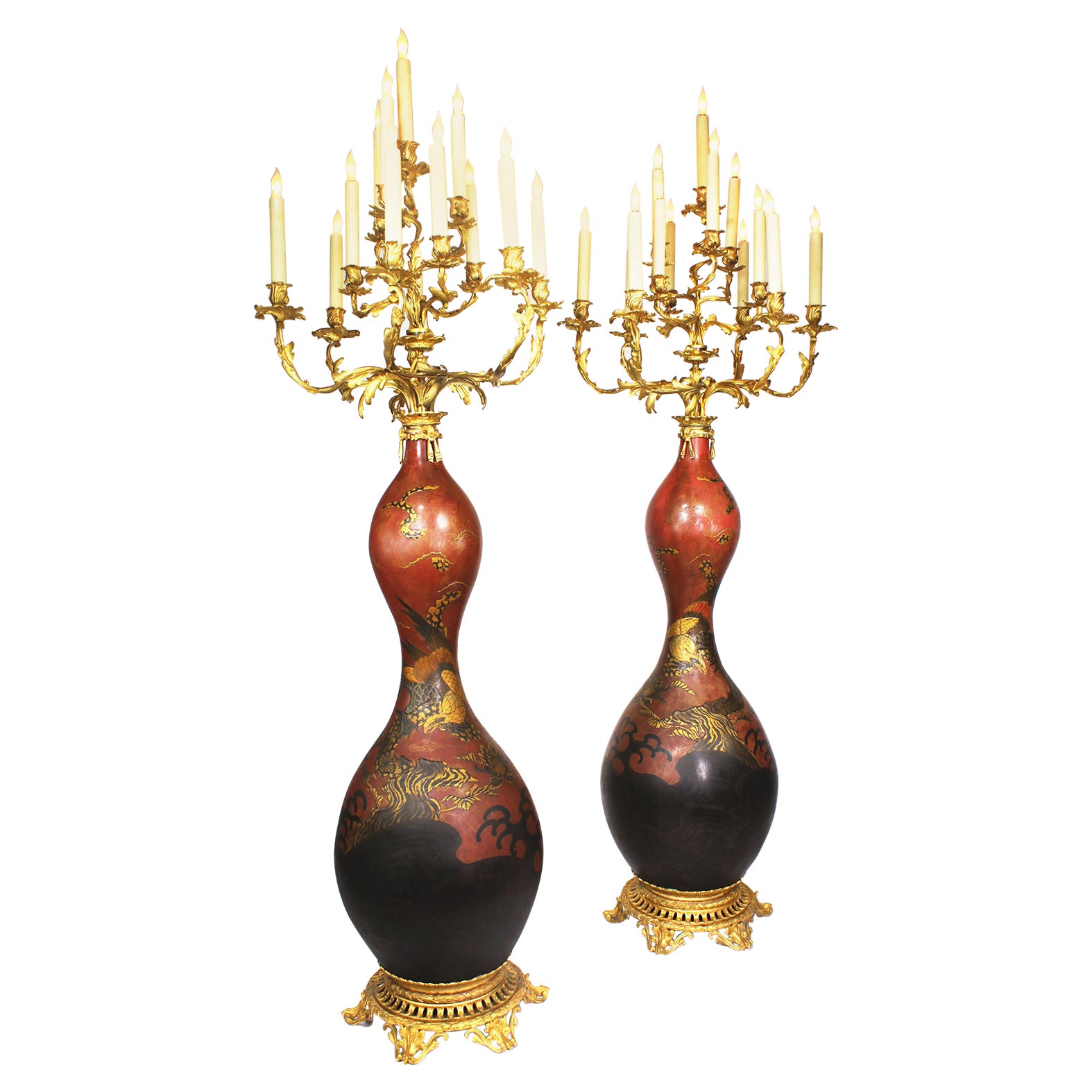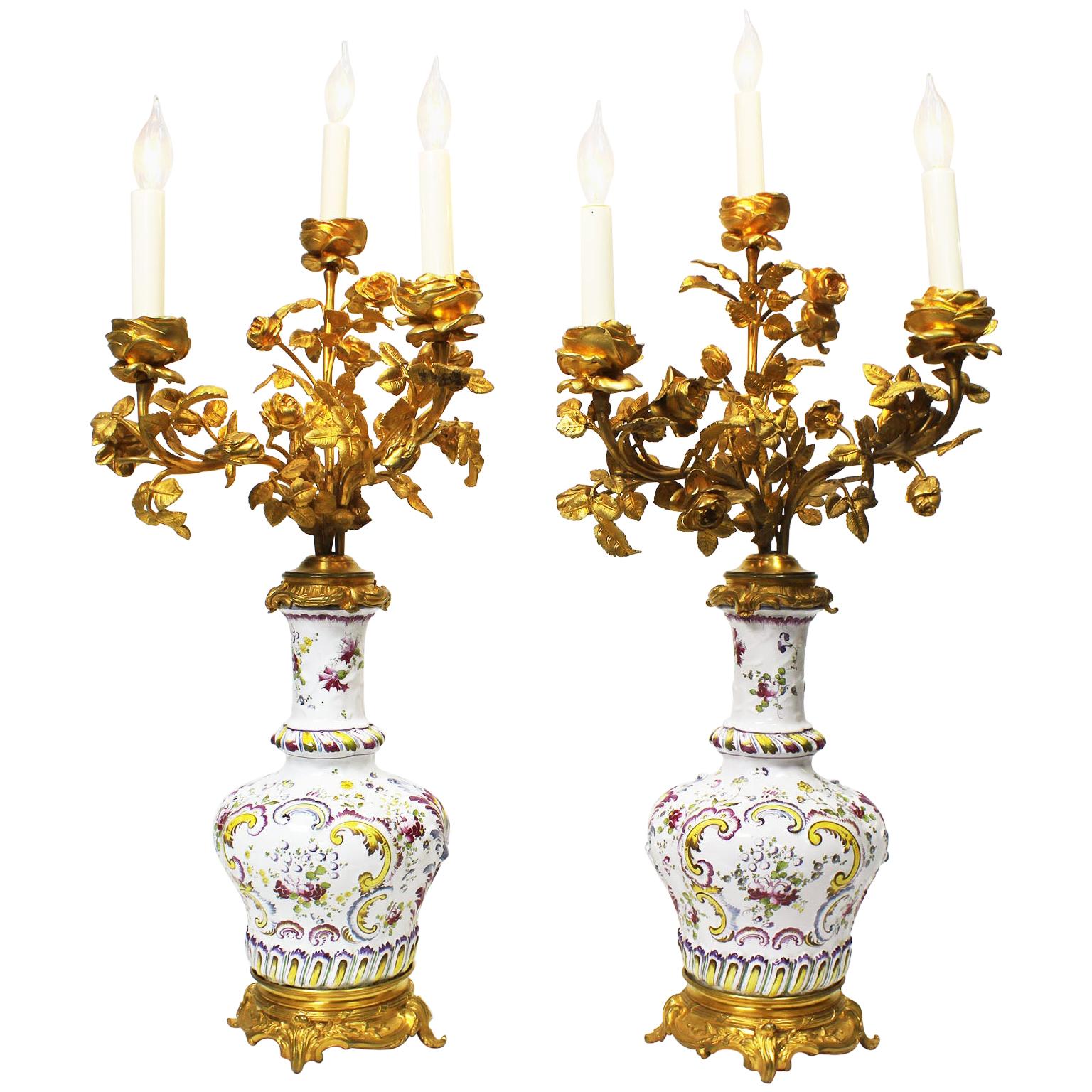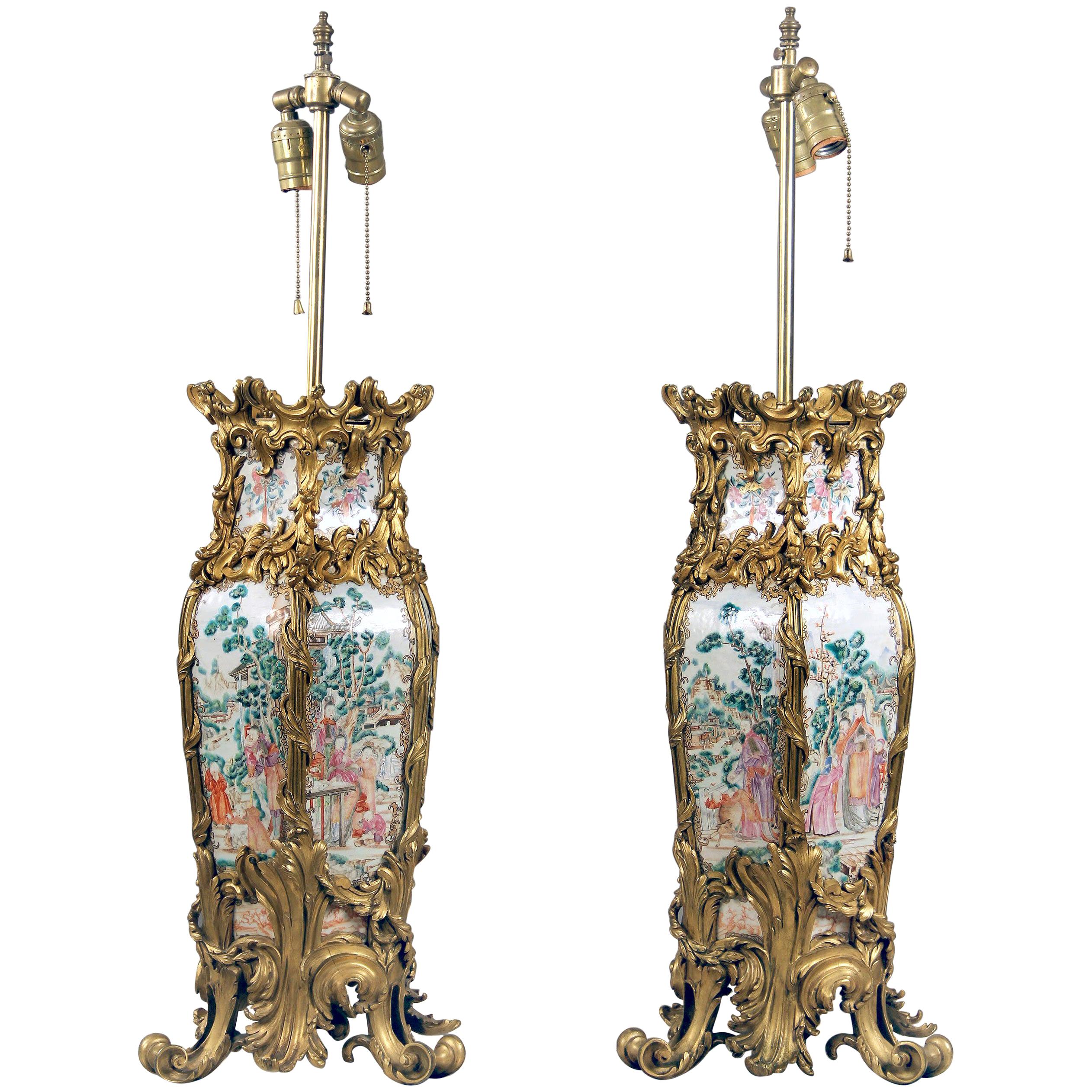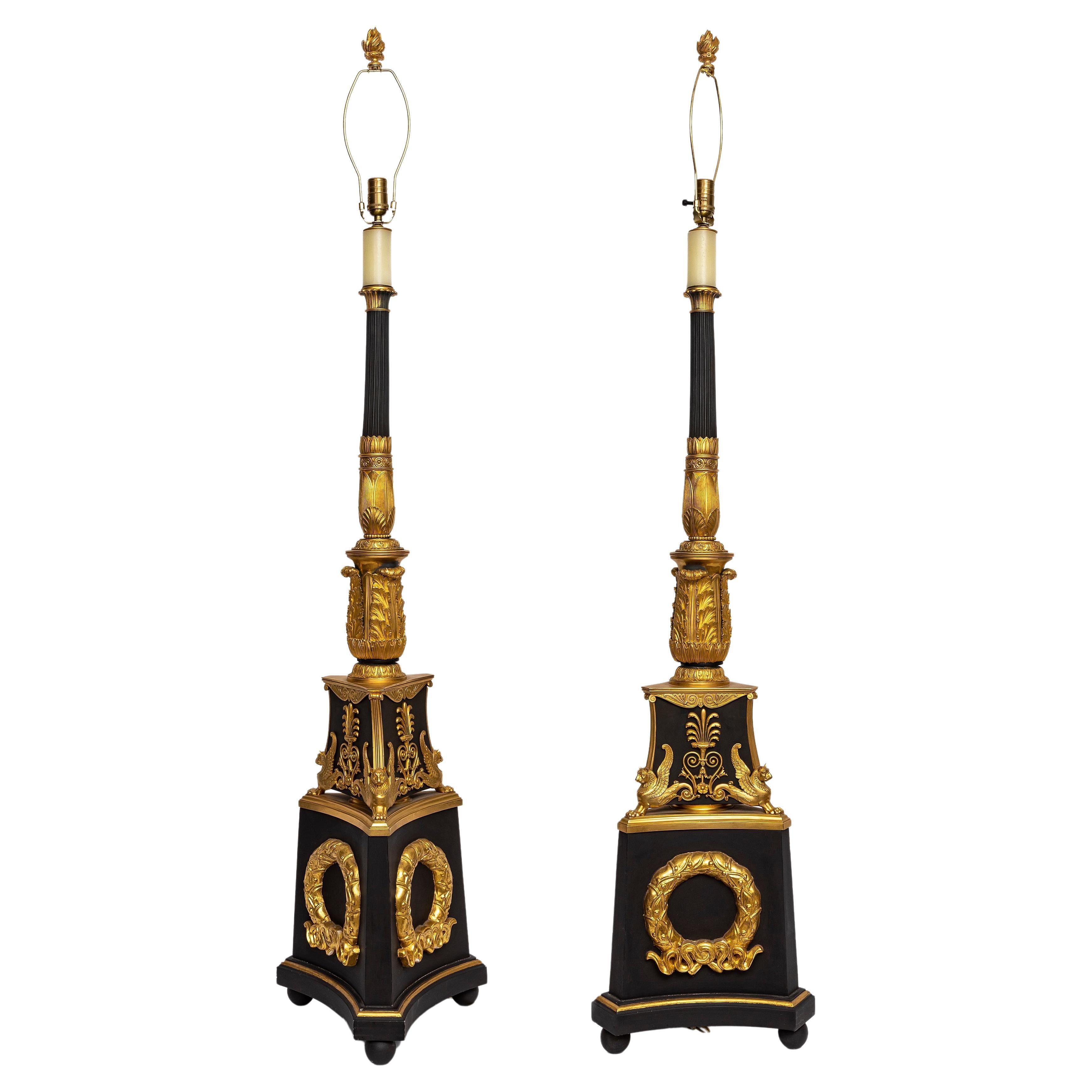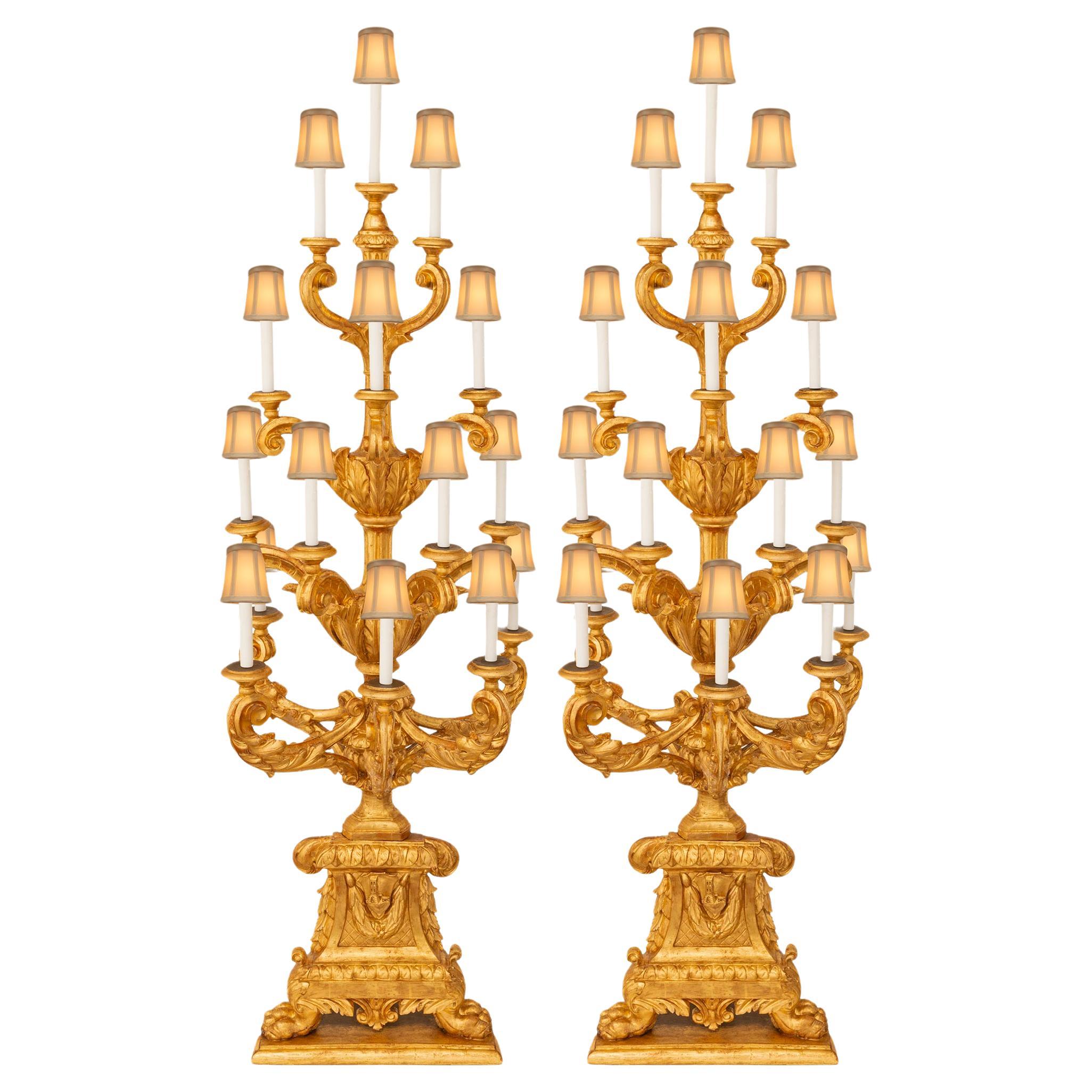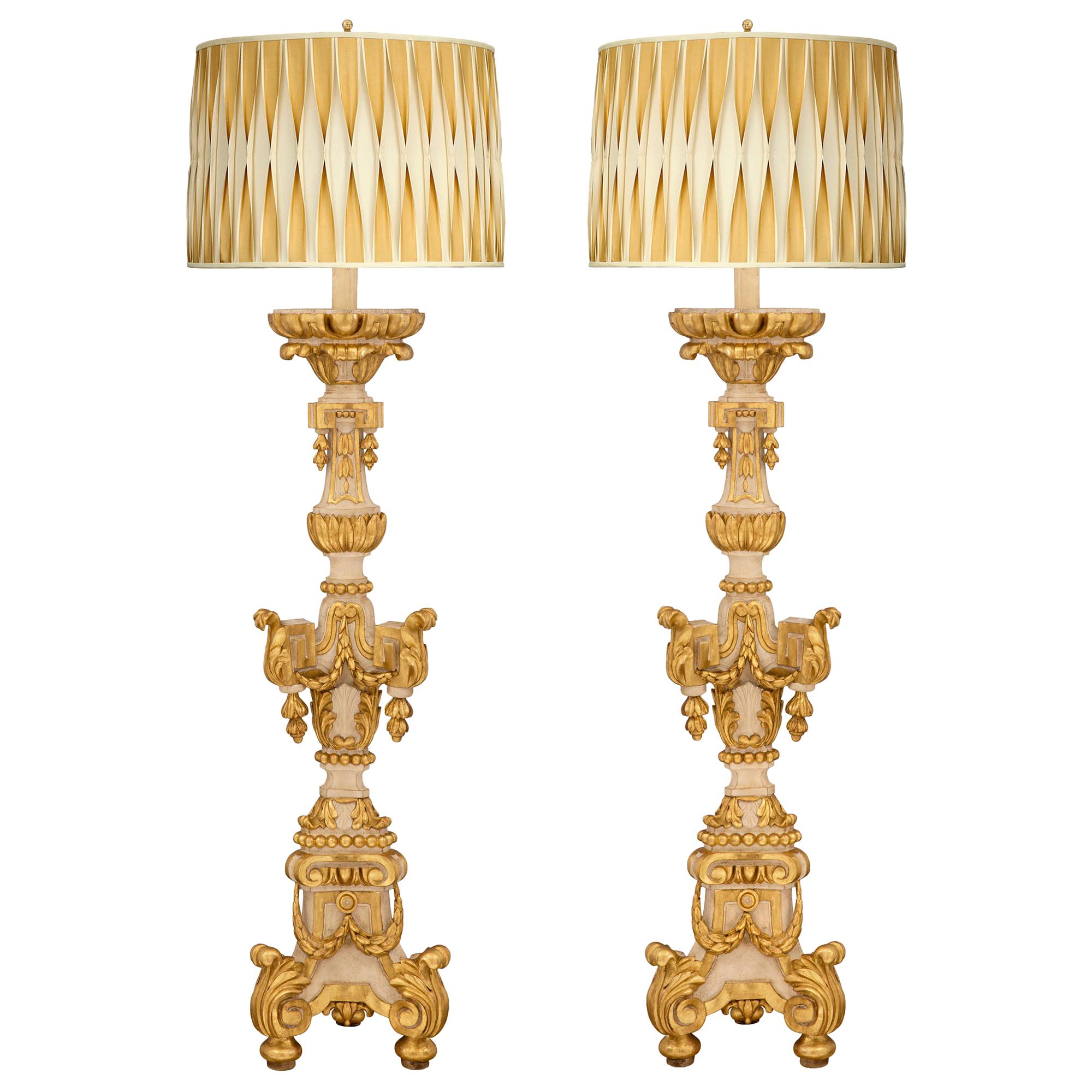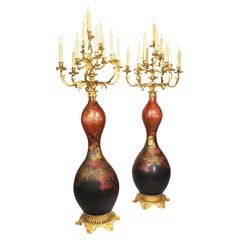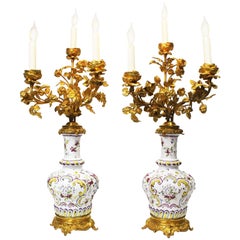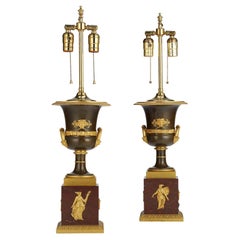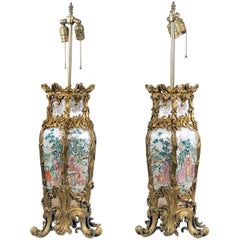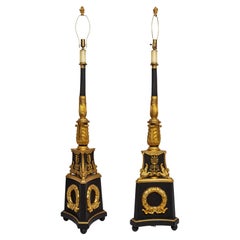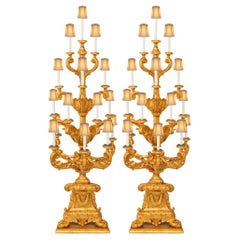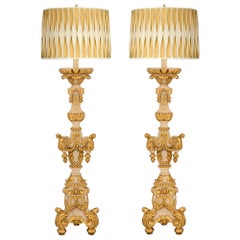Items Similar to Pair 19th Century Japanese Porcelain and Gilt Bronze Mounted Torchere Floor Lamp
Want more images or videos?
Request additional images or videos from the seller
1 of 7
Pair 19th Century Japanese Porcelain and Gilt Bronze Mounted Torchere Floor Lamp
$29,850per set
£22,545per set
€26,055.36per set
CA$41,869.19per set
A$46,562.60per set
CHF 24,373.37per set
MX$568,007.05per set
NOK 306,260.28per set
SEK 288,077.34per set
DKK 194,486.30per set
About the Item
A fine pair of 19th century Japanese porcelain and French gilt bronze mounted thirteen-light celadon torchiere, floor lamp candelabra. Wired for electricity, circa 1880-1890.
Overall Height: 64 1/4 inches (163 cm).
- Attributed to:Imari Porcelain (Manufacturer)
- Dimensions:Height: 64.25 in (163.2 cm)Diameter: 25 in (63.5 cm)
- Sold As:Set of 2
- Style:Rococo (In the Style Of)
- Materials and Techniques:
- Place of Origin:
- Period:
- Date of Manufacture:circa 1880-1890
- Condition:Repaired: Touch ups. Wear consistent with age and use. Minor losses. Minor fading. Wired for electricity. Prior to installation the entire electrical wiring system and structure must be inspected, verified and approved by a licensed electrical contractor.
- Seller Location:Los Angeles, CA
- Reference Number:Seller: Ref.: A21271stDibs: LU179624252173
About the Seller
5.0
Vetted Professional Seller
Every seller passes strict standards for authenticity and reliability
Established in 1982
1stDibs seller since 2016
135 sales on 1stDibs
Typical response time: 1 hour
- ShippingRetrieving quote...Shipping from: Los Angeles, CA
- Return Policy
Authenticity Guarantee
In the unlikely event there’s an issue with an item’s authenticity, contact us within 1 year for a full refund. DetailsMoney-Back Guarantee
If your item is not as described, is damaged in transit, or does not arrive, contact us within 7 days for a full refund. Details24-Hour Cancellation
You have a 24-hour grace period in which to reconsider your purchase, with no questions asked.Vetted Professional Sellers
Our world-class sellers must adhere to strict standards for service and quality, maintaining the integrity of our listings.Price-Match Guarantee
If you find that a seller listed the same item for a lower price elsewhere, we’ll match it.Trusted Global Delivery
Our best-in-class carrier network provides specialized shipping options worldwide, including custom delivery.More From This Seller
View AllPair 19th Century Japanese Imari Porcelain & Gilt-Bronze Torchere Candelabra
By Imari Porcelain
Located in Los Angeles, CA
A fine Pair of 19th century Japanese Imari Porcelain and French Gilt-Bronze Mounted Thirteen-Light Celadon Torchere Candelabra. The bottle-shaped Japonisme vases with a Royal red background, decorated with parcel-gilt and black soaring eagles in the hunt within a forestall scene. Each Vase fitted and surmounted with a French 19th century Louis XV Style 13-Light scrolled candelabrum and all raised on a circular pierced gilt-bronze plinth. circa: 1880.
Imari Porcelain (????) is the name for Japanese porcelain wares made in the town of Arita, in the former Hizen Province, northwestern Kyushu. They were exported to Europe extensively from the port of Imari, Saga, between the second half of the 17th century and the first half of the 18th century. The Japanese as well as Europeans called them Imari. In Japanese, these porcelains are also known as Arita-yaki (???). Imari or Arita porcelain has been continously produced up through the present day.
Characteristics
Though there are many types of Imari, Westerners' conception of Imari in the popular sense is associated only with a type of Imari produced and exported in large quantity in mid-17th century. This type is called Kinrande. Kinrande Imari is colored porcelain with cobalt blue underglaze and red and gold overglaze. The color combination was not seen in China at that time. Traditional Ming dynasty color porcelain used dominantly red and green, probably due to scarcity of gold in China, whereas gold was abundant in Japan in those days. The subject matter of Imari is diverse, ranging from foliage and flowers to people, scenery and abstractions. Some Imari design structures such as kraak style were adopted from China, but most designs were uniquely Japanese owing to the rich Japanese tradition of paintings and costume design. The porcelain has a gritty texture on the bases, where it is not covered by glaze. There is also blue and white Imari. Kakiemon style Imari is another type of Imari, but it tends to be categorized separately in Europe.
History
"Imari" was simply the trans-shipment port for Arita wares. It was the kilns at Arita which formed the heart of the Japanese porcelain industry.
Arita's kilns were set up in the 17th century, when kaolin was discovered in 1616 by the immigrant Korean potter, Yi Sam-pyeong (1579–1655). (He may also be known by the name, "Kanage Sambei".) Yi Sam-Pyeong, along with his extended family of 180 persons, left Korea on the offer of a privileged position in Japan. This decision was made after the occurrence of certain Japanese invasions of Korea. After Yi Sam-Pyeong's discovery, his kilns began to produce revised Korean-style blue and white porcelains, known as "Shoki-Imari".
In the mid-17th century there were also a lot of Chinese refugees in Northern Kyushu due to the turmoil on Chinese continent, and it is said one of them brought coloring technique to Arita. Thus Shoki-Imari developed into Ko-KutaniImari. Ko-Kutani was produced around 1650 for both export and domestic market. Blue and white porcelain continued to be produced and they are called Ai-Kutani. Ko-Kutani Imari for the export market usually adopted Chinese design structure such as kraak style, whereas Ai-Kutani for the domestic market were highly unique in design and are accordingly valued very much among collectors.
Ko-Kutani style evolved into Kakiemon style Imari, which was produced for about 50 years around 1700. Imari achieved its technical and aesthetic peak in Kakiemon style, and it dominated European market. Blue and white Kakiemon is called Ai-Kakiemon. Kakiemon style transformed into Kinrande in the 18th century. Kinrande used blue underglaze and red and gold overglaze, and later some other colors.
Imari began to be exported to Europe because the Chinese kilns at Ching-te-Chen were damaged in the political chaos and the new Qing dynasty government stopped trade in 1656–1684. Exports to Europe were made through the Dutch East India Company, but the designation "Imari Porcelain" in Europe connotes Arita wares of mostly Kinrande Imari.
Export of Imari to Europe stopped in mid-18th century when China began export to Europe again, since Imari was not able to compete against China due to high labor cost. By that time, however, both Imari and Kakiemon style were already so popular among Europeans, Chinese export porcelain copied both Imari and Kakiemon style, which is called Chinese Imari. At the same time, European kilns, such as Meisen also tried to copy Imari and Kakiemon.
Export of Imari surged again in late 19th century (Meiji era) when Japonism flourished in Europe. Thus in western world today, two kinds of Imari can...
Category
Antique 19th Century Japanese Japonisme Floor Lamps
Materials
Bronze, Ormolu
$24,850 Sale Price / set
49% Off
Pair of 19th Century Gilt-Bronze & Faience Porcelain Table Lamp Candelabras
Located in Los Angeles, CA
A fine pair of French 19th-20th century Louis XV style gilt bronze and Faience porcelain three-light candelabra table lamps. The ovoid porcelain urn hand decorated in floral burgundy...
Category
Antique Early 1900s French Louis XV Table Lamps
Materials
Bronze, Ormolu
Pair French 19th-20th Century Louis XV Style Gilt Bronze & Cut-Glass Table Lamps
Located in Los Angeles, CA
A fine pair of French 19th-20th century Louis XV style gilt bronze and cut-glass three-light Girandoles table lamps. (Electrified), Paris, circa 1900.
Height: 33 inches (84 cm).
...
Category
Antique Early 1900s French Louis XV Table Lamps
Materials
Bronze
Pair French 19th Century Napoleon III Empire Style Gilt-Bronze Urn Table Lamps
By Pierre-Philippe Thomire
Located in Los Angeles, CA
A very fine pair of French 19th century Napoleon III Empire style patinated-bronze and gilt-bronze Mounted Allegorical covered Urn vases lamps in the manner of Pierre-Philippe Thomir...
Category
Antique Late 19th Century French Empire Revival Table Lamps
Materials
Marble, Brass, Bronze, Ormolu
$12,950 Sale Price / set
31% Off
Pair of 19th Century Rococo Ormolu & Griotte Marble Candelabra, Barbedienne
By Ferdinand Barbedienne
Located in Los Angeles, CA
A fine pair of French 19th century Rococo Revival style gilt bronze and Rouge Griotte marble six-light candelabra attributed to Ferdinand Barbedienne (French, 1810-1892) After a mode...
Category
Antique Late 19th Century French Rococo Revival Table Lamps
Materials
Griotte Marble, Bronze, Ormolu
$12,950 Sale Price / set
30% Off
Pair of 19th-20th Century Pâte-sur-Pâte Porcelain and Gilt-Bronze Table Lamp
Located in Los Angeles, CA
A fine pair of French 19th-20th century Pâte-sur-Pâte Porcelain and gilt-bronze mounted ovoid-shaped table lamps with a white low-relief floral design carved in slip and applied to a contrasting body over the blue-green porcelain, Paris, circa 1900.
Pâte-sur-pâte is a French term meaning "paste on...
Category
Antique Early 1900s French Rococo Revival Table Lamps
Materials
Bronze
$3,400 Sale Price / set
20% Off
You May Also Like
Pair of Late 19th Century French Gilt Bronze Mounted Chinese Porcelain Lamps
Located in Long Island City, NY
A Nice Quality Pair of Late 19th Century French Gilt Bronze Mounted Chinese Porcelain Lamps
Fine bronze mounts separate the six painted panels decorated with chinoiserie figures in ...
Category
Antique Late 19th Century French Belle Époque Table Lamps
Materials
Bronze, Ormolu
Pair of 19th C. French Ormolu & Patinated Bronze Torchieres/floor lamps
Located in New York, NY
An Incredible and Large Pair of 19th Century Empire Period French Ormolu and Patinated Bronze Mounted Torchieres. The patinated bronze base is decorated with hand-chassed and hand-c...
Category
Antique 1820s French Empire Floor Lamps
Materials
Bronze
pair of Italian 18th century Baroque st. Giltwood Torchière floor lamps
Located in West Palm Beach, FL
An impressive and high quality pair of Italian 18th century Baroque st. Giltwood Torchière floor lamps. Each freestanding fifteen light torchière is raised by a square tapered base w...
Category
Antique 18th Century Italian Baroque Floor Lamps
Materials
Giltwood
Pair of Italian 18th Century Baroque Period Patinated and Giltwood Floor Lamps
Located in West Palm Beach, FL
A magnificent and very large scale pair of Italian 18th-century Baroque period patinated and giltwood floor lamps. Each statement-making torchière floor lamp is raised by elegant top...
Category
Antique 18th Century Italian Baroque Floor Lamps
Materials
Wood, Giltwood
Vintage Chinoiserie James Mont Style Tall Gold Gilt Metal Table Lamps - a Pair
Located in Philadelphia, PA
Vintage Chinoiserie James Mont Style Tall Gold Gilt Metal Table Lamps - a Pair. Item features tall pierced decorated metal body, applied butterfly accents, ebonized metal base, great...
Category
Mid-20th Century Unknown Chinoiserie Table Lamps
Materials
Metal
Pair 19th Century Monumental Ormolu, Patinated Bronze Thirteen-Light
By Albert-Ernest Carrier-Belleuse
Located in Dublin 8, IE
Both are modelled as robed female figures holding aloft thirteen scrolled candlearms, on marbleized bronze plinths hung with ribbons and fruiting garlands, on pawfeet. After Albert-E...
Category
Antique Mid-19th Century European Victorian Floor Lamps
Materials
Bronze, Ormolu
More Ways To Browse
Japanes Porcelain
Porcelain Lamps Pair
Antique Lamps Porcelain
19th Century Japanese Porcelain
Antique Imari
French Porcelain Lamps
Brown Porcelain Lamp
French Rococo Porcelain
Fine Porcelain Lamps
19th French Porcelain Lamp
Antique Japanese Lamp
Japanese Antique Lighting
French Porcelain And Bronze Lamp
Pair Of Japanese Lamps
Japanese Bronze Lamps
Japanese Porcelain Lamp
19th Century Japanese Lamps
Rococo Antique Lamps Rococo Lamps
